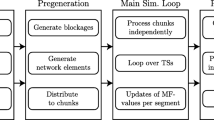Abstract
In this paper, we present a novel and efficient data-flow oriented simulation platform for the downlink of Long Term Evolution Advanced (LTE-A). This tool accounts for a wide set of configuration parameters from LTE-A physical and medium access control layers as well as different traffic sources. The simulator, which is implemented in C++, does not consider any link abstraction mechanism, leading to accurate and realistic results. As a case of study, we investigate the performance of cell-offloading for different deployments of small cell base stations that differ in the distance towards their nearest macro base station under File Transfer Protocol type traffic. Additionally, the impact of the spatial user distribution on the performance of cell-offloading is assessed. Results reveal that aggregated throughput is maximized when macro base stations are highly offloaded, which means that a high bias for cell association is advisable in terms of aggregated throughput. However, if the fairness among users is also taken into account, the selected bias for cell-offloading should be smaller.










Similar content being viewed by others
References
Carreras, A., Aguayo-Torres, M. C., Martin-Vega, F. J., Gomez, G., Blanquez, F., Delgado-Luque, I. M., & Entrambasaguas, J. T. (2018). Link abstraction models for multicarrier systems: A logistic regression approach. International Journal of Communication Systems. https://doi.org/10.1002/dac.3436
Mehlfhrer, C., Colom Ikuno, J., Šimko, M., Schwarz, S., Wrulich, M., & Rupp, M. (2011). The Vienna LTE simulators-enabling reproducibility in wireless communications research. EURASIP Journal on Advances in Signal Processing, 2011(1), 29. https://doi.org/10.1186/1687-6180-2011-29.
Virdis, A., Stea, G., & Nardini, G. (2014). SimuLTE – A modular system-level simulator for LTE/LTE-A networks based on OMNeT++. In 2014 4th International Conference On Simulation And Modeling Methodologies, Technologies And Applications (SIMULTECH), pp. 59–70. https://doi.org/10.5220/0005040000590070.
Piro, G., Grieco, L. A., Boggia, G., Capozzi, F., & Camarda, P. (2011). Simulating LTE cellular systems: An open-source framework. IEEE Transactions on Vehicular Technology, 60(2), 498–513. https://doi.org/10.1109/TVT.2010.2091660.
Baldo, N., Miozzo, M., Requena-Esteso, M., & Nin-Guerrero, J. (2011). An open source product-oriented LTE network simulator based on ns-3. In Proceedings of the 14th ACM International Conference on Modeling, Analysis and Simulation of Wireless and Mobile Systems. ACM, New York, MSWiM ’11, pp. 293–298. https://doi.org/10.1145/2068897.2068948.
Aguayo-Torres, M.C. et Al. (2016). WM-SIM LTE link simulator version 2. Tech. rep., Universidad de Málaga. https://riuma.uma.es/xmlui/handle/10630/11057?show=full.
Andrews, J. G., Singh, S., Ye, Q., Lin, X., & Dhillon, H. S. (2014). An overview of load balancing in hetnets: Old myths and open problems. IEEE Wireless Communications, 21(2), 18. https://doi.org/10.1109/MWC.2014.6812287.
Singh, S., & Andrews, J. (2014). Joint resource partitioning and offloading in heterogeneous cellular networks. IEEE Transactions on Wireless Communications, 13(2), 888. https://doi.org/10.1109/TWC.2013.120713.130548.
Damnjanovic, A., Montojo, J., Wei, Y., Ji, T., Luo, T., Vajapeyam, M., et al. (2011). A survey on 3GPP heterogeneous networks. IEEE Wireless Communications, 18(3), 10. https://doi.org/10.1109/MWC.2011.5876496.
Ali, M. S., Coucheney, P., & Coupechoux, M. (2016). Load balancing in heterogeneous networks based on distributed learning in near-potential games. IEEE Transactions on Wireless Communications, 15(7), 5046. https://doi.org/10.1109/TWC.2016.2551744.
Martin-Vega, F. J., Gomez, G., Aguayo-Torres, M. C., & Renzo, M. D. (2016). Analytical modeling of interference aware power control for the uplink of heterogeneous cellular networks. IEEE Transactions on Wireless Communications, 15(10), 6742. https://doi.org/10.1109/TWC.2016.2588469..
Martin-Vega, F. J., Delgado-Luque, I. M., Gomez, G., Aguayo-Torres, M. C., & Entrambasaguas, J. T. (2016). Downlink power setting for energy efficient heterogeneous cellular networks. In 2016 8th International congress on ultra modern telecommunications and control systems and workshops (ICUMT), pp. 147–151. https://doi.org/10.1109/ICUMT.2016.7765348.
Delgado-Luque, I. M., Aguayo-Torres, M. C., Gómez, G., & Entrambasaguas, J. T. (2017). A framework to evaluate fairness in fractional frequency reuse based cellular networks. Wireless Personal Communications, 95(2), 287. https://doi.org/10.1007/s11277-016-3892-6.
Xie, M., Ye, W., Feng, S., & Song, H. (2005). Performance of a queuing model with Pareto input traffic for wireless network nodes. In Proceedings of international conference on wireless communications, networking and mobile computing, 2005, Vol. 2, pp. 867–870. https://doi.org/10.1109/WCNM.2005.1544188.
Sesia, S., Toufik, I., & Baker, M. (2009). LTE, The UMTS long term evolution: From theory to practice. New York: Wiley Publishing.
Martin-Vega, F., Blanquez-Casado, F., Lopez-Martinez, F., Gomez, G., & Entrambasaguas, J. (2015). Further improvements in SOVA for high-throughput parallel turbo decoding. IEEE Communications Letters, 19(1), 6. https://doi.org/10.1109/LCOMM.2014.2371041.
Han, B., & Zheng, Y. R. (2015). Higher rank principal Kronecker model for triply selective fading channels with experimental validation. IEEE Transactions on Vehicular Technology, 64(5), 1654. https://doi.org/10.1109/TVT.2014.2332518.
Delgado-Luque, I. M., Blanquez-Casado, F., Fuertes, M. G., Gomez, G., Aguayo-Torres, M. C., Entrambasaguas, J. T., & Baños, J. (2012). Evaluation of latency-aware scheduling techniques for M2M traffic over LTE. In Proceedings of the 20th European signal processing conference (EUSIPCO), pp. 989–993.
3GPP, Evolved Universal Terrestrial Radio Access (E-UTRA); Further advancements for E-UTRA physical layer aspects. TR 36.814, 3rd Generation Partnership Project (3GPP) (2017).
3GPP, Technical Specification Group Radio Access Network; Coordinated multi-point operation for LTE physical layer aspects. TR 36.819, 3rd Generation Partnership Project (3GPP) (2013).
Author information
Authors and Affiliations
Corresponding author
Additional information
This work has been supported by the Spanish Government (Ministerio de Economía y Competitividad) and FEDER under grant TEC2016-80090-C2-1-R and by the Universidad de Málaga.
Rights and permissions
About this article
Cite this article
Carreras, A., Delgado-Luque, I.M., Martín-Vega, F.J. et al. A System-Level Simulator for the Downlink of LTE-A: Case of Study—Cell-Offloading in HetNets. Wireless Pers Commun 100, 177–191 (2018). https://doi.org/10.1007/s11277-018-5616-6
Published:
Issue Date:
DOI: https://doi.org/10.1007/s11277-018-5616-6




